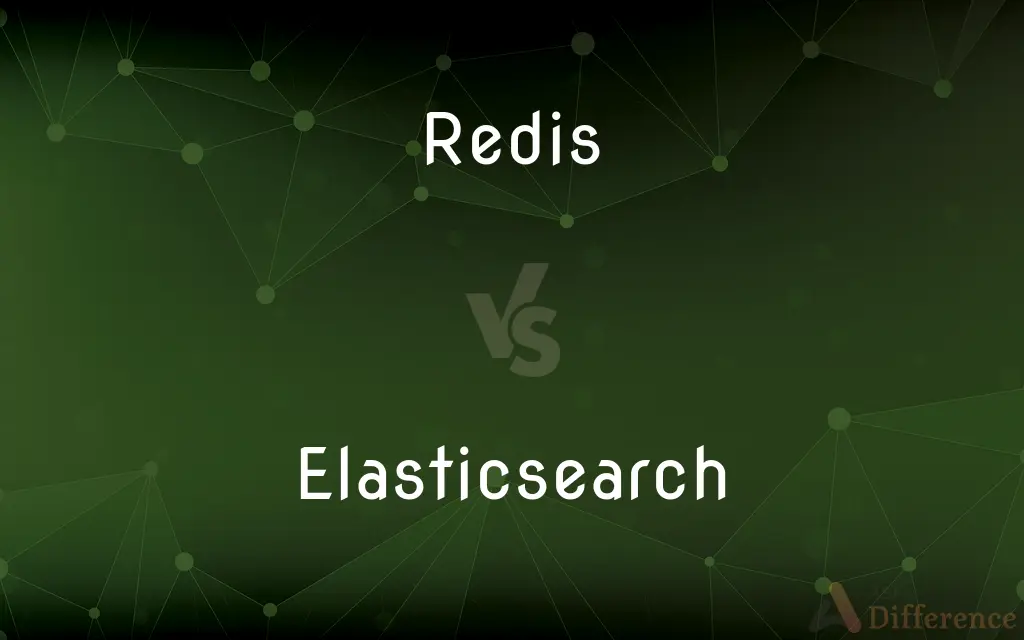Redis vs. Elasticsearch — What's the Difference?
By Maham Liaqat & Fiza Rafique — Updated on March 21, 2024
Redis is an in-memory data structure store used for caching and messaging, while Elasticsearch is a search engine based on the Lucene library, optimized for full-text search and analytics.

Difference Between Redis and Elasticsearch
Table of Contents
ADVERTISEMENT
Key Differences
Redis, standing for Remote Dictionary Server, is primarily used as an in-memory key-value store designed to quickly retrieve and store data, serving as a cache, database, or message broker. Its strength lies in its ability to handle high-speed transactions, session caching, and real-time analytics. Elasticsearch, on the other hand, excels in searching and analyzing large volumes of textual data. It is used extensively for log and event data analysis, real-time application monitoring, and providing complex search functionalities.
While Redis is known for its simplicity, speed, and efficiency in handling relatively straightforward data structures like strings, lists, sets, and hashes, Elasticsearch provides a more complex query language and data model designed for text analysis, including full-text search capabilities with relevance scoring. This makes Elasticsearch particularly powerful for scenarios requiring deep search functionality over large datasets.
Redis operates primarily in memory, which contributes to its lightning-fast performance. It has persistence options, but its primary design is for scenarios where speed is critical, and data can be volatile. Elasticsearch, while also capable of quick data retrieval, stores data on disk, allowing it to manage and search vast amounts of data that wouldn't fit into memory.
The use cases for Redis often involve session caching, real-time analytics, and speeding up the performance of web applications by caching frequently accessed data. Elasticsearch is typically used for log aggregation and analysis, full-text searching, and complex data analysis tasks across large datasets. For example, it powers the search and analytics features of many popular applications and websites.
Integrating Redis and Elasticsearch can offer the best of both worlds: Redis can quickly access and manage data structures for immediate application needs, while Elasticsearch can perform complex searches and analytics on the same dataset. This combination is common in architectures that require both fast data access and sophisticated search capabilities over the same data.
ADVERTISEMENT
Comparison Chart
Type
In-memory data structure store
Search and analytics engine
Primary Use
Caching, messaging
Full-text search, analytics
Data Model
Key-value pairs, simple data structures
Document-oriented, complex queries
Performance
High-speed transactions
Optimized for search and analysis
Storage
In-memory (with persistence options)
Disk-based
Use Cases
Session caching, real-time analytics
Log analysis, full-text search
Query Capabilities
Basic operations on data structures
Complex text search and analytics
Compare with Definitions
Redis
Supports various data structures.
Redis handles lists, sets, and hashes for real-time applications.
Elasticsearch
Real-time data analysis.
Elasticsearch is used for analyzing and visualizing log data in real time.
Redis
Persistence options available.
Despite being in-memory, Redis offers persistence mechanisms.
Elasticsearch
Document-oriented search engine.
It allows for storing and searching large volumes of textual data.
Redis
In-memory key-value store.
Redis is used for caching web page data to decrease loading times.
Elasticsearch
Based on the Lucene library.
Elasticsearch excels in full-text search and complex analytics.
Redis
High-performance caching.
Redis can serve as a session cache to enhance website performance.
Elasticsearch
Complex query language.
It supports a wide range of queries for deep data analysis.
Redis
Used as a message broker.
Redis supports Pub/Sub messaging patterns for real-time data processing.
Elasticsearch
Scalable and distributed nature.
Elasticsearch can efficiently handle large datasets across multiple nodes.
Redis
Redis (; Remote Dictionary Server) is an in-memory data structure store, used as a distributed, in-memory key–value database, cache and message broker, with optional durability. Redis supports different kinds of abstract data structures, such as strings, lists, maps, sets, sorted sets, HyperLogLogs, bitmaps, streams, and spatial indices.
Elasticsearch
Elasticsearch is a search engine based on the Lucene library. It provides a distributed, multitenant-capable full-text search engine with an HTTP web interface and schema-free JSON documents.
Common Curiosities
Is Redis suitable for data persistence?
While not its primary use case, Redis does offer data persistence options to safeguard data against loss.
Can Elasticsearch handle real-time data processing?
Yes, Elasticsearch can process and analyze data in real time, making it suitable for applications requiring immediate insights.
How does Elasticsearch perform analysis on textual data?
Elasticsearch uses the Lucene library to perform complex text analysis and search operations, including tokenization and filtering.
Can Redis support complex queries like Elasticsearch?
Redis has limited query capabilities compared to Elasticsearch; it excels in data structure operations rather than text analysis.
How do Redis and Elasticsearch manage data scalability?
Redis can replicate data across multiple nodes for scalability, while Elasticsearch distributes data across a cluster to handle large datasets efficiently.
Can Redis be used as a primary database?
Yes, Redis can be used as a primary database, though it's often used for caching due to its in-memory nature.
What is a common scenario for using both Redis and Elasticsearch together?
A common scenario is using Redis for caching and quick data access, while Elasticsearch is used for performing complex searches and analysis on the same data.
Which is better for analytics, Redis or Elasticsearch?
Elasticsearch is specifically designed for analytics, especially when dealing with textual data, making it the better choice for such tasks.
What makes Elasticsearch suitable for search applications?
Its ability to quickly index and search large volumes of text, along with its sophisticated analysis capabilities, makes it ideal for search applications.
How does Redis achieve its speed?
Redis stores data in memory, allowing for rapid access and manipulation of data structures.
Share Your Discovery

Previous Comparison
Earth vs. Neutral
Next Comparison
Grumble vs. ComplainAuthor Spotlight
Written by
Maham LiaqatCo-written by
Fiza RafiqueFiza Rafique is a skilled content writer at AskDifference.com, where she meticulously refines and enhances written pieces. Drawing from her vast editorial expertise, Fiza ensures clarity, accuracy, and precision in every article. Passionate about language, she continually seeks to elevate the quality of content for readers worldwide.
















































